In the last post you saw how Julia Moore used a sourdough levain to start to make cider. Here the circle is completed as the sediment from the racked cider is used to ferment a sourdough.
There’s a tradition of using the foam of a beer ferment or the brewing leftovers to make a ‘Barm Bread’.
Here’s a BBC ‘Food Programme’ piece about Barm Bread which explains the method and some history.
So when Julia told me she was going to make bread with her cider leftovers, I was pretty confident she’d have a good result. Julia is ‘barmy’ but not at all silly!
Here’s Julia’s recipe in her own words.
Cider barm sourdough bread recipe
Ingredients
Save 175ml of liquor in each litre bottle. Shake up the bottle to incorporate all the sediment and the barm collected at the neck of the bottle. Now use the 350ml of cider barm to make some bread.
To the cider barm add:
- 560g white organic bread flour
- 2tsp salt
- 2tbsp honey.
Method
Mix and knead the dough in your usual manner.
The dough felt quite unresponsive, and after working the dough a few times periodically over 3 hrs it still didn’t really feel like it wanted to relax, certainly not in the same way that sourdough usually does.
I shaped the dough into a boule shape, rolled it in a mix of rye and rice flour so it wouldn’t stick to the teacloth and then rested it at room temperature in a cloth lined bowl.
After an hour it still looked and felt unresponsive, so I took the unusual step of placing the dough in the airing cupboard, something I’d never do normally but then this was not a normal bake.
12 hrs later the dough looked relaxed, happy and ready to bake. So I had learnt something. While sourdough likes cool temperatures, cider barm likes warm temperatures!
Pre-heat your oven to 225°C
Sprinkle the base of the dough with wholewheat semolina and then carefully tip the dough onto a baking sheet. Slash the top of the dough in any design you like and bake for 40mins, turning the temperature down to 200°C half way through baking.
Result
The bread has a soft golden textured interior and is encased in a dark chewy crust.
It has pleasing apple flavours with a hint of digestive biscuits!
Delicious with cheese. Our favourite, Barkham Blue from Two Hoots…
So the cider barm bread is a success but we will have to wait a few months to find out about the cider.
*****
Great work from Julia there. She asks me to say that you could use any organic bread flour to make this – she happened to use white this time.
I would have made a sponge or poolish using the barm, honey and about 200g or so of the flour first and let this start to ferment over night. Then I’d have included the rest of the flour and the salt and continued as normal – Carl
Have you made anything similar? Do let Julia and me know in the comments
Another twitter pal, Jessica, was inspired by this bread to make bread using a wine barm. See her Wine Barm Sourdough post.

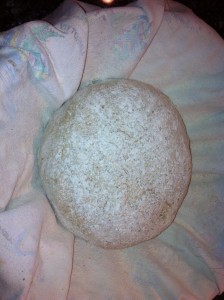
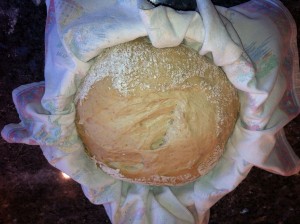
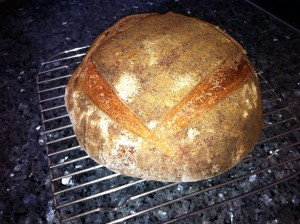
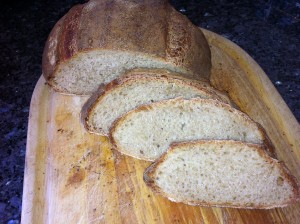
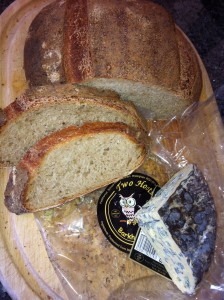
Comments
25 responses to “Cider barm sourdough bread”
[…] twitter pal Jessica read the earlier post on how to use a cider barm to make sourdough bread. Serendipity is a wonderful thing as Jessica was racking wine that day. So Jessica contacted me on […]
Thanks very much for sharing this bread project. I volunteer as a living history demonstrator at local historic sites here in the U.S and I’ve made bread from my own mead and wine lees using recipes from 18th and 19th century cookbooks. Before the 20th century, many brewers sold their lees by the quart to housewives who used them to bake bread. Waste not, want not, as they say! I’m glad to see this method returning to favor, especially since homebrewing leaves us with quantities of lees and it would be a shame to waste all that good flavor.
Hi Laura
That’s really interesting information, thanks so much for sharing it with us. I’m shortly going to post a recipe another blog follower made using wine lees.
Would you be able to tell me the titles of the cookbooks you refer to, I’d like to see if I can find them over here or on line.
Cheers
Carl
Hi Carl,
The first cookbook in which I encountered this use is American Cookery by Amelia Simmons (1796). This cookbook, along with a number of other 18th to 20th century American cookbooks, are available online here:http://digital.lib.msu.edu/projects/cookbooks/html/browse.html through the Michigan State University libraries. In this cookbook the dregs from brewing are referred to as ’emptins,’ a word that still hangs around in some larger dictionaries.
Later cookbooks such as The Carolina Housewife by Sarah Rutledge simply refer to the substance as ‘yeast’ but you know it doesn’t mean modern yeast because a typical amount called for in a bread recipe is a teacupful. Rural women who didn’t have access to a brewery’s leftovers and who didn’t brew their own alcoholic beverages at home resorted to a homemade yeast mixture like the very first recipe in The Carolina Housewife.
I’m afraid all my resources at this point are American cookbooks since I’m doing my best to be accurate for historical demonstrations here where I live. But I’m sure the same technique applies elsewhere – commercial yeast simply wasn’t available before the late 19th or early 20th century. So you might have a look through any early European cookbooks you can find; the amount of yeast called for in a recipe will tell you that it’s dregs and not dry yeast.
Cheers,
Laura
Hi Laura
Thanks so much for sharing your research.
I love the word emptins, so very descriptive 🙂
You will have me lost in the MSU digital library now for days, what a great resource. And I’ve no problem with American cookbooks. Some of my best preserving books are from the US. Were you able to listen to the BBC piece I linked to in this post. If not, let me know and I’ll find a work around for you.
Thanks so much for your speedy reply.
Best wishes
Carl
Yes, I managed to listen to the BBC program. Very interesting! Enjoy yourself in the MSU digital collections – good stuff. 🙂
This conversation prompted me to reach for my Mrs Beeton. She makes several comments in her general introduction to bread making:
“All manner of leavening matter have, however, been, and are still used in different parts of the world; in the East Indies, “toddy,” which is a liquor that flows from the wounded cocoa-nut tree; and, in the West Indies, “dunder,” or the refuse from the distillation of rum.” Then some description of how yeast works in bread dough…
“The yeast must be good and fresh if the bread is to be digestible and nice. Stale yeast produces, instead of vinous fermentation, an acetous fermentation, which flavours the bread and makes it disagreeable. A poor thin yeast produces an imperfect fermentation, the result being a heavy unwholesome loaf.” I think I’ve baked a few of those! Several paragraphs on other matters follow, then,
“Yeast from home-brewed beer is generally preferred to any other; it is very bitter, and, on that account, should be well washed, and put away until the thick mass settles. If it still continues bitter, the process should be repeated; and before being used, all the water floating at the top must be poured off. German yeast is now very much used, and should be moistened, and thoroughly mixed with the milk or water with which the bread is to be made.”…
“Yeast must always be good of its kind, and in a fitting state to produce ready and proper fermentation. Yeast of a strong beer or ale produces stronger effect than that of milder kinds; and the fresher the yeast, the smaller the quantity will be required to raise the dough.”
Then in the next chapter she gives the following recipe:
TO MAKE YEAST FOR BREAD
INGREDIENTS.- 1 1/2 oz. of hops. 3 quarts of water. 1 lb. of bruised malt, 1/2 pint of yeast.
Mode.- Boil the hops in the water for 20 minutes; let it stand for about 5 minutes, then add it to 1 lb of bruised malt prepared as for brewing. Let the mixture stand covered till about lukewarm; then put in not quite 1/2 pint of yeast; keep it warm, and let it work 3 or 4 hours; then put it into small 1/2-pint bottles (ginger-beer bottles are the best for the purpose), cork them well, and tie them down. The yeast is now ready for use; it will keep good for a few weeks, and 1 bottle will be found sufficient for 18 lbs. of flour. When required for use, boil 3 lbs. of potatoes without salt, mash them in the same water in which they were boiled, and rub them through a colander. Stir in about 1/2 lb. of flour; then put in the yeast, pour it in the middle of the flour, and let it stand warm on the hearth all night, and in the morning let it be quite warm when it is kneaded. The bottles of yeast require very careful opening, as it is generally exceedingly ripe. ” That’s 7 or 8 bottles of yeast, each of which is good for 18 lb flour, and will last for just a few weeks!
The following two recipes for bread call for “1 quartern of flour, 1 large tablespoonful of solid brewer’s yeast, or nearly 1 oz of fresh German yeast, 1 1/4 to 1 1/2 pint of warm milk-and-water.” and, “3 lbs of potatoes, 6 pints of cold water, 1/2 pint of good yeast, a peck of flour, 2 oz. of salt.”
It’s not clear how the recipe for yeast relates to the bread recipes. I’d only comment that it’s not surprising she found brewing yeast too bitter for bread if the first thing she did with it was add hops!
Hi Rachel
What a star you are too! 🙂
Dunder is an interesting word. According to my Shorter OED, it comes form the Spanish redundar meaning overflow and dates to about 1793.
And toddy comes from the Hindu word for the sap of the palm tree which had been cut to obtain it. It dates from about 1609.
Just brilliant!
Thanks so much.
Cheers
Carl
I’m going to get my copy of Mrs B out of the loft now!
You’re so right about the hopped brewing ‘yeast’ – would be a very puckering experience 😉
Oh Rachel, I like that homemade yeast recipe – it’s similar to the first recipe in The Carolina Housewife, also calling for hops and brewing your own, so to speak, in terms of making up batches of yeast for baking. I suspect the hops were added for their preservative power (like the incredibly huge amount of hops added to India Pale Ale so it would survive the lengthy shipment through the tropics), though I have to agree, the bitterness would give a possibly unpleasant edge. Sadly, I don’t have a copy of Mrs. Beeton’s cookbook. Thus far my collection focuses on North America, but I think I need to broaden my horizons. Mrs. B was quite the innovator in her time.
Yes, I wondered whether the hops might be for preservative reasons, but she only reckons it will last a few weeks, so she doesn’t their effectiveness very much!
I suspect how long it lasts has to do with the temperature of the kitchen. Remember, a century or more ago, there was a wood stove or large fireplace with a hot fire burning almost around the clock in the kitchen. I can tell you from experience, the kitchen stays toasty warm even if the rest of the (pre-central-heat) house is freezing. LOL
I make beer from malt extract and often use the yeast for bread. I take it after the first fermentation – which I do in a bucket – but before the second, in bottles. I think this is the same point that Julia took hers off, though my bucket is two gallons, not one litre! I take the beer out of the bucket with a jug, taking care not to disturb the yeast sediment in the bottom (I think I have bottom-feeding yeast, but as I keep it going from one brew to the next, I’ve lost track. I haven’t yet managed to catch wild yeast.). Of course some gets stirred up, but not too much. When I’ve got as much beer out as I can, I swirl the last bit around to loosen the yeast, which I then transfer to a pot for more convenient access.
I really couldn’t tell you how much of this I use in bread – too much, usually. I often get two loaves out of this, as well as keeping some back to start the next batch of beer. I use a “no knead” method and a very simple recipe:
1 lb flour (standard wholemeal or cheapest white)
1 tsp salt
water to make a wet-ish dough
yeast
Mix, leave overnight, knock back and persuade into a tin, leave to rise for a couple of hours at (fairly cool, or warm in summer) room temperature, then bake at gas mark 6 for 45 min (or until I remember – it’s remarkably tolerant of being forgotten).
This makes excellent bread – the maltiness goes very well in wholemeal bread, in particular. I believe that the quality of my bread depends mainly on the quality of the yeast, and fresh yeast that’s very recently been dining on malt extract seems to work very well.
Rachel
Thanks so much for taking the time to write such a detailed comment.
Some really useful and interesting stuff there, I’m very grateful to you.
I have some beer to make this month using my own dried hops and I’ll definitely take some barm off as you suggest. If all goes well, (even if not) I’ll blog the results and let you know.
I have another friend on twitter who has just made a loaf with the lees from her wine ferment. We really have caught an idea that seems to have found its time 🙂
Thanks again
Carl
Have you made your beer yet? I thought you might be interested in how I got on with the same project: Foraged Food Friday: Hops
It’s on the list for the next few days Rachel. And your blog post very interesting.
Do you have Andy Hamilton’s “Booze for Free”. He has two recipes for beer with hops that you may find useful and some great other recipes too.
Cheers
Carl
I don’t have his book, though it was an article of his that got me started on malt extract brewing (progressing from kit beer). I get most of my information from the internet, which is extremely stingy of me – I really should support people like Andy!
If you joined Twitter Rachel, Andy is quite active there and very helpful 🙂
He’s pretty active and helpful on his own forum, too 😉
(Selfsufficientish, in case you don’t know it, though it’s a bit quiet at the moment due to technical difficulties).
Haha, true. I have the book and end up on the forum from google 😀
That looks amazing! In the spirit of intercontinental fermentary sharing a fellow blogger and I experimented using kefir as a raising agent last year. She used finished milk kefir and I used my homemade non-dairy finished kefir (made with kefir converted to feeding on a mix of homemade sesame milk and date paste) in order to see if it would work. Both experiments worked amazingly well and it was awesome to see that we could use our kefir as an alternative to sourdough (which I fail at managing to keep going on a regular basis). I hear you can also use Kombucha for the same thing but haven’t tried it yet. This communal knowledge sharing is awesome! Cheers for the excellent cider barm share 🙂
I love all your experiments, they are great! I would probably do the same as Carl and make a pre-ferment of some sort, if you had concentrated apple juice syrup you could always use that to feed it with as well for extra sugar at that stage to keep the appley flavours really strong in the dough.
I feed my rye starter with a mix of concentrated apple juice syrup and raw milk kefir………just love the appley taste with the rye.
Elaine.
I bet your rye starter says “Thank-you” after it’s fed 🙂 I’ll have a try with that myself.
Thanks Elaine
Carl, the rye starter is just amazing. I have been using to make a rye, fig and hazelnut bread to eat with cheese.
Awesome sounds yummy